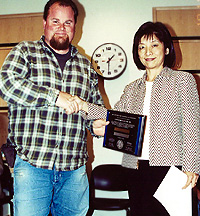Construction Workforce Program: Putting San Franciscans to Work

 |
| Stella Hsu, associate vice chancellor, right, recognizes a contractor for hiring San Francisco residents on UCSF projects. |
- The housing complex had a total of 1,892 workers with 227 (12 percent) resident workers. Of the resident workers, 69 were apprentices.
- The community center and adjacent parking garage had a total of 1,925 workers with 196 (10 percent) resident workers. Of the resident workers, 63 were apprentices.
Mike Theriault, secretary-treasurer of SFBTC, says the program has led to a construction workforce that reflects the city's diversity and helps local residents reap the benefits of UCSF's construction boom. "This program works quite well," he says. "Men and women working in the trades are starting to look like California in terms of its ethnic makeup. This kind of partnership has been useful to advance diversity in the workforce." Theriault also says this program is great for strengthening working families. "If an institution is to be welcomed in a community like Mission Bay, especially part of an area that has seen its share of difficulties, then it should help address its needs." Michael Adams, director of the UCSF Office of Affirmative Action, Equal Opportunity and Diversity (AA/EO/D), agrees. "This has really been a labor of love, and many people in San Francisco can see their fingerprints all over it," Adams says. "Mission Bay, once a place of old rail yards and unproductive land, has helped create not only opportunities for employment within the University, but also construction jobs for those who live in the surrounding neighborhoods." Monitoring Success
To succeed, the workforce program relies on making contractors aware of qualified local workers in a timely manner. Mark Paschal, associate director of AA/EO/D, coordinates the program and manages the recognition events as projects are completed. Terry Rawlins, construction compliance officer, carefully monitors the construction schedule for UCSF projects to inform community-based agencies about when hiring opportunities will become available for workers in specific building trades. Monjett Graham, data analyst, evaluates data from monthly certified payrolls to determine workforce participation by zip code. He then produces reports that monitor use of residents at each project. These reports support recognition for best practices by contractors. The workforce program emphasizes hiring goals contained in the contract, and ensures that discussions take place with community-based agencies at the time work crews are being assembled for specific portions of the overall project. A prebid conference gives all candidates interested in bidding on a UCSF contract the knowledge to do so, and after bids are awarded, two preconstruction conferences help to ensure that prime contractors and subcontractors discuss their hiring needs directly with the community-based agencies. "Our goal is to encourage contractors to increase the percentage of workers who live in San Francisco," Rawlins says. "And better utilization of local workers produces a more diverse workforce." The other agencies participating in the program are Chinese for Affirmative Action, Mission Hiring Hall, Ella Hill Hutch Community Center, Potrero Hill Neighborhood House, Young Community Developers, Inc. and the Glide Memorial Church Construction Program. For more information on the UCSF Community Construction Workforce Program, call Mark Paschal, program coordinator, at 415/476-1019.